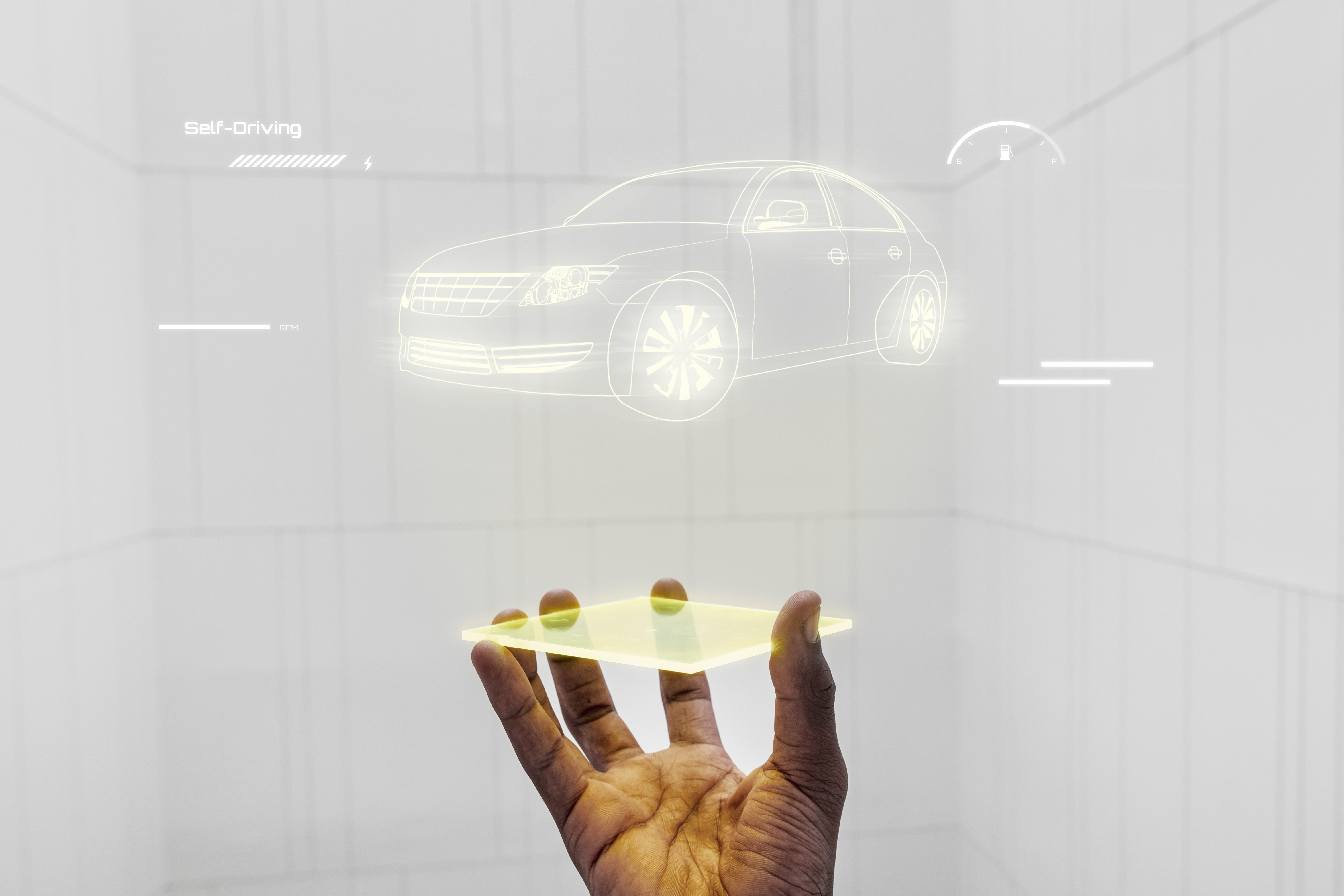.png)
The Future Is Here: 2025’s Global AI Trends in Automotive Marketing
The Future Is Here: 2025’s Global AI Trends in Automotive Marketing
The Shift We’re All Experiencing
Car buying no longer starts at the dealership. For most people, it begins on a screen scrolling through listings, browsing social feeds, or exploring online marketplaces. The physical showroom is now the second step, not the first.
But the digital world is crowded. Thousands of cars compete for attention, and buyers are quick to swipe past anything that doesn’t look polished. The challenge for dealerships and OEMs isn’t just showing up online; it’s standing out.
This is where Artificial Intelligence (AI) is changing the game. As highlighted in Top Automotive Marketing Trends for 2025, AI has become more than a buzzword it’s a strategic necessity. From enhancing car photos to personalizing ads, AI is reshaping the way vehicles are marketed, sold, and even experienced online.
The Rise of AI in Automotive Marketing
AI in this sector isn’t futuristic it’s already working quietly behind the scenes. Dealerships use AI-powered photo editors to turn parking-lot snapshots into studio-grade images. Chatbots handle late-night inquiries. Algorithms decide which cars to promote based on shifting demand.
These aren’t “nice-to-have” add-ons anymore. They’re the foundation of a digital-first strategy. Dealerships that embrace them are pulling ahead; those that hesitate risk fading into the background noise of the internet.
Key AI Applications in Automotive Marketing
1. Smarter Car Photography
First impressions matter especially online. Buyers scrolling through hundreds of listings pause only when a photo grabs their attention. AI-driven tools like background removal, shadow addition, and detail enhancement transform ordinary images into professional, consistent, and “scroll-stopping” visuals.
Instead of relying on costly studio setups, dealerships can now achieve studio quality in seconds. This isn’t just about aesthetics; listings with high-quality visuals sell faster and often at better prices.
2. 360° Views and Immersive Experiences
Flat photos aren’t enough anymore. Consumers want to rotate, zoom, and explore vehicles online before they step onto a lot. AI makes it possible to create interactive 360° spins and virtual walkarounds from just a handful of images.
This trend, popularized by online-first players, is now becoming mainstream as traditional dealerships adopt digital showrooms to keep pace.
3. Personalized Interactions at Scale
Shoppers don’t want generic “Summer Sale” ads. They want offers that feel tailored to their needs. AI analyzes browsing patterns, past inquiries, and demographics to deliver personalized recommendations whether through chatbots, email campaigns, or dynamic ad placements.

Instead of waiting for business hours, a customer researching financing at 11 p.m. can get instant answers from an AI assistant. Instead of a blanket promotion, a young family might see safety-focused SUVs while a budget-conscious student sees compact cars with low running costs.
4. Social Media Optimization
Social platforms are no longer optional in automotive marketing; they’re central. AI helps dealerships compete in the “scroll economy” by predicting the best posting times, suggesting captions and hashtags, and identifying which visuals drive engagement.
As Automotive Social Media Marketing Trends & Tips 2025 points out, a consistent, polished feed doesn’t just get likes it builds brand authority and drives leads back to the dealership site.
Transition Challenges and Practical Solutions
The Investment Question
The first hesitation many dealerships feel about AI is cost. Software subscriptions, system integrations, and staff training don’t come free. For smaller dealers, it can feel overwhelming.
But here’s the shift in mindset: AI isn’t an expense, it’s an investment. Clean visuals, consistent branding, and smarter targeting translate into faster sales and stronger margins. The real question isn’t “How much will this cost me?” but “How much am I losing by not using it?”
Start Small, Scale Smart
Adopting AI doesn’t mean flipping a switch overnight. The smartest dealerships take a phased approach:
This step-by-step approach keeps disruption low while building internal confidence. Each success makes the next stage easier.
The Human Factor Resistance and Reassurance
Technology isn’t always the biggest hurdle people are. Sales teams may be skeptical of “machines taking over” and marketers might fear losing control.
But AI isn’t here to replace them. It’s here to take repetitive work off their plate so they can focus on what humans do best: building trust, telling stories, and closing deals. As one executive put it: “AI doesn’t remove the human touch; it gives us back the time to use it where it matters.”

Streamlining Operations with AI
Automating the Mundane
From scheduling social media posts to updating inventory descriptions, AI thrives on repetitive tasks. The payoff is efficiency, consistency, and fewer errors. For leaders, it also means freeing up resources for strategy instead of firefighting small bottlenecks.
Predictive Analytics – Data That Thinks Ahead
Beyond automation, AI’s real power is foresight. By analyzing patterns in browsing data, seasonal demand, and past sales, predictive analytics can guide smarter decisions.
Imagine knowing that compact SUVs will spike in demand next quarter before your competitors do. Or identifying which online behaviors mean a buyer is ready to test-drive. Instead of guessing, you’re planning with precision.
Preparing for a Future Dominated by AI
Staying Ahead The Need for Continuous Adaptation
AI won’t stand still. Tools that feel cutting-edge today like instant background removal or automated ad targeting will be standard features tomorrow. The real challenge for dealerships is not adopting AI once, but learning to adapt continuously.
The winners will be those who:
Think of AI less like software you bought and more like a language your business is learning one you’ll keep getting better at over time.
Building a Tech-Savvy Workforce
AI works best when paired with human expertise. That means developing a workforce that’s not just “using tools” but actively leveraging them.
Key focus areas:
Dealerships that thrive will be those where teams welcome AI, rather than fear it.
The Human-AI Balance
Car buying is still an emotional decision. Shoppers may be impressed by AI-enhanced photos or personalized recommendations, but when it comes to finalizing a deal, they still want a human touch.

AI predicts what a buyer is looking for; people understand why. The future isn’t man versus machine it’s man plus machine.
Looking Beyond 2025
The horizon is even more exciting:
As these innovations roll out, dealerships that experiment now will be ready to ride the next wave instead of scrambling to catch up.
Conclusion – The Road Ahead Is Digital
AI is no longer an optional experiment for the automotive industry it’s the new standard. From transforming car photos into showroom-quality images, to enabling immersive 360° views, to delivering personalized ads and insights, AI is reshaping every step of the customer journey.
The dealerships and OEMs that embrace AI in 2025 won’t just keep pace they’ll set the pace. By streamlining operations, empowering staff, and offering customers richer, more personalized experiences, they’ll stand out in an increasingly competitive digital landscape.
The road ahead is digital, powered by AI. The question isn’t if you should adopt it it’s how fast you’re willing to accelerate.
Expanded FAQ
Q1: How does AI specifically benefit automotive photography?
AI takes what used to be a time-consuming, manual process and turns it into something efficient, scalable, and consistent. Traditionally, dealerships relied on photographers, editing software, and hours of post-production to make car photos look professional. With AI, background removal happens instantly, shadows are automatically added to create depth, and reflections or highlights are enhanced to make vehicles appear polished.
But the benefits go beyond aesthetics. High-quality visuals directly influence buyer behavior. A crisp, clean photo makes a listing stand out on crowded marketplaces, encourages more clicks, and builds trust in the dealership’s brand. Buyers are more likely to believe that a dealership with professional images is also professional in service. AI ensures that every vehicle from compact hatchbacks to luxury SUVs gets the same consistent treatment, regardless of where or how it was photographed.
Q2: Can AI in automotive marketing improve customer satisfaction?
Yes, and in multiple ways. First, AI enhances responsiveness. When a potential buyer reaches out late at night with a question about financing or vehicle features, an AI chatbot can provide accurate, real-time answers something that would have been impossible outside of business hours a few years ago. That immediate support prevents frustration and keeps buyers engaged.
Second, AI enables personalization at scale. Instead of generic ads or one-size-fits-all follow-up emails, customers receive recommendations tailored to their browsing history, budget range, and preferences. For example, a family browsing SUVs might be shown content focused on safety ratings and cargo space, while a younger buyer researching electric cars might see charging details and performance stats. This makes customers feel seen and understood, which builds trust.
Finally, AI reduces friction in the buying process. Predictive tools can recommend vehicles likely to fit a customer’s needs, optimize the checkout process online, or even anticipate questions before they are asked. All of this adds up to a smoother, more satisfying experience.
Q3: What are the initial costs associated with integrating AI into automotive marketing?
The cost of adopting AI can vary widely depending on the scale and tools a dealership chooses. At the basic level, subscription fees for AI photo editing or chatbot services are relatively affordable and can deliver quick wins. Mid-level investments might involve integrating AI into CRM systems to analyze leads, automate follow-ups, and improve targeting. Larger, enterprise-level implementations such as predictive analytics platforms or custom AI integrations come with higher costs, including setup, customization, and staff training.
Training is a key part of the cost structure that often gets overlooked. AI tools may be designed to be user-friendly, but staff still need time to learn how to use them effectively. For example, a marketing manager may need to understand how to interpret AI-generated insights to adjust campaigns strategically.
The encouraging news is that many dealerships start small. By focusing on one or two tools first, they can see ROI quickly often through faster sales and reduced marketing waste before scaling to larger, more sophisticated AI investments.
Q4: How does AI help in understanding consumer behavior?
AI excels at turning large amounts of raw data into clear, actionable insights. Every click on a website, every scroll through a photo gallery, every saved vehicle, and every inquiry is a data point. On their own, these actions may not reveal much. But when AI analyzes thousands of such actions across hundreds of buyers, patterns emerge.
For instance, AI might detect that interest in compact SUVs rises sharply in spring, or that buyers who watch a 360° video are twice as likely to book a test drive. These insights help dealerships allocate their marketing spend more effectively, prioritize which vehicles to highlight, and tailor messaging to what resonates most with their audience.
AI can also segment buyers into more precise categories. Instead of broad “age” or “income” demographics, it identifies micro-segments like “tech-savvy professionals interested in hybrids” or “families prioritizing third-row seating.” This level of understanding makes marketing more efficient and targeted.
Q5: Is AI difficult to integrate into existing systems?
Integration can sound intimidating, but many modern AI solutions are designed to “plug in” with minimal disruption. Photo editing platforms, for example, often work directly with existing inventory management systems, so edited photos are automatically updated in listings. Chatbots can be layered onto dealership websites without major redesigns.
That said, complexity depends on the scope. A dealership adding a single AI feature like automated photo editing will have a far easier path than one implementing predictive analytics across multiple sales channels. The biggest challenges typically involve ensuring data flows correctly between systems (CRM, DMS, advertising platforms) and training staff to use the tools effectively.
Fortunately, most providers in the automotive space understand these concerns and offer onboarding support, tutorials, and integrations built specifically for dealership workflows. In practice, this means the barrier to entry is much lower than it might seem and the long-term benefits of seamless integration far outweigh the short setup phase.
